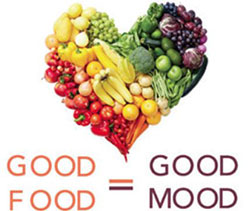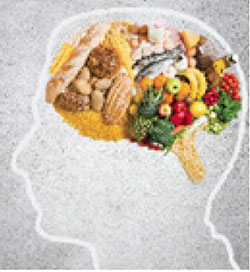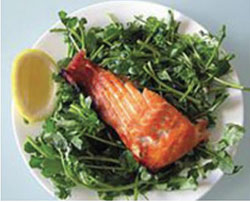Connecting Mental Health & Nutrition
Shelby Rundell-Le, 4-H Youth Development/Family & Consumer Science Agent, Gunnison County

We have all heard it before, you need to eat to fuel your body or the well-known, “you are what you eat”. Nutrition plays an important role in your physical health, but did you know there is also a connection to your mental health? Though the relation may not be clear, most of us would agree that our mental clarity and emotions are somehow connected by how much and what we put into our bodies. Just in case you didn’t remember mom saying, “food is the best medicine”, you need to eat well to function.
How Food Impacts Our Mental Health
Our brains are constantly working, they take care of our thoughts, movements, breathing, heartbeats and senses. Even while we sleep, our brains are working 24/7. Since our brains work endlessly, they need a continuous supply of fuel. This fuel comes from the foods that we eat, and what is in that fuel can impact the brain. Simply put, what we eat directly affects our brain, and our moods.

Much like an expensive car, our brains work best when they get premium fuel. Higher-quality foods contain lots of vitamins, minerals and antioxidants which feed the brain and protect it from stress. Also like a car, our brains can be damaged if we eat lower quality foods. For example, diets high in refined sugars can be harmful to the brain, while also harming your body’s regulation of insulin, promoting inflammation. Not consuming enough foods such as vegetables, fruits, fish, wholegrains etc., can led to not getting enough nutrients, antioxidants and fiber, which can weaken our immune systems, change our stomach bacteria and other aspects of mental and physical health.
If we want our bodies and minds to perform their best, we need to eat good food. So which foods should we avoid and which promote health? Try to eat a balance of healthy foods that will supply the proteins, carbohydrate, fats, enzymes, etc. that the brain tissue needs to function.
Foods to Eat More Of:
- Nuts, seeds
- Fruits, vegetables
- Wholegrains, beans, legumes
- Fish, poultry, lean red meats, eggs
- Healthy fats, such as olive oil, avocado
Foods to Eat Less Of:
- Foods high in saturated fat such as butter, cheese, sausage, and pastries
- Foods with added sugars like soda, candy, baked goods, and jams
- Foods with refined carbohydrates such as white pasta, white bread, cookies, and crackers
Foods to Avoid:
- Processed foods that contain trans fats like packaged baked goods and shortening
Let’s Talk
Talk to children about the connection between Good Food and Good Mood. In fact, cut out the first picture and
related words in this article and put it on your refrigerator or pantry door. Remind children to pick-out and take
healthy snacks with them when they head out for a busy day of activities. As a family try eating a cleaner more
nutrient dense diet for a few weeks, eliminating most processed foods and refined sugars. Notice the effects on the
energy and mood of yourself and family members, and then talk about it.
Tips for Success:
- Don’t skip meals: provide your body and brain a steady supply of fuel, eat consistently through the day to help
prevent blood sugar ups and downs. - Snack well: keep your energy up by packing healthy snacks. Try keeping nuts, whole or dried fruit in your bag.
- Work on balance: your brain needs a healthy supply of macronutrients; protein, carbohydrates and fats to perform
its important jobs. - Don’t over-diet: you should eat to be healthy and active, not to fit into a pair of jeans. This method can be harmful
to your body.
Recipes for Health:
Zesty Lemon Dill Salmon

Ingredients:
- Aluminum foil
- 2 four-ounce salmon fillets
- 1 tablespoon olive oil
- 2 tablespoons lemon juice
- 1 clove garlic, minced
- 1 tablespoon fresh dill
- 1 teaspoon lemon pepper
- ¼ teaspoon sea salt (optional)
Directions:
- Pre-heat oven to 450F, spray two sheets of aluminum foil with an oil cooking spray.
- Place each salmon fillet on top of aluminum foil.
- Mix together olive oil, lemon juice, and minced garlic in a small bowl and pour over fillets.
- Sprinkle fresh dill, lemon pepper, and sea salt (optional) over salmon fillets.
- Cover fillets with piece of aluminum foil and pinch edges together with bottom piece of aluminum foil.
- Place packet on a cookie sheet to bake in the oven for 15 minutes.
- Remove packet from the oven and cool for 5 minutes before opening.
- Serve and enjoy with seasonal vegetables, green salad or wholegrain.
Recipe sourced from CSU Kendall Anderson Nutrition Center





